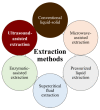Antioxidant and Antidiabetic Properties of Phlorotannins from Ascophyllum nodosum Seaweed Extracts
- PMID: 37446599
- PMCID: PMC10343254
- DOI: 10.3390/molecules28134937
Antioxidant and Antidiabetic Properties of Phlorotannins from Ascophyllum nodosum Seaweed Extracts
Abstract
Seaweeds have gained considerable attention in recent years due to their potential health benefits and high contents of bioactive compounds. This review focuses on the exploration of seaweed's health-promoting properties, with particular emphasis on phlorotannins, a class of bioactive compounds known for their antioxidant and antidiabetic properties. Various novel and ecofriendly extraction methods, including solid-liquid extraction, ultrasound-assisted extraction, and microwave-assisted extraction are examined for their effectiveness in isolating phlorotannins. The chemical structure and isolation of phlorotannins are discussed, along with methods for their characterization, such as spectrophotometry, nuclear magnetic resonance, Fourier transform infrared spectroscopy, and chromatography. Special attention is given to the antioxidant activity of phlorotannins. The inhibitory capacities of polyphenols, specifically phlorotannins from Ascophyllum nodosum against digestive enzymes, such as α-amylase and α-glucosidase, are explored. The results suggest that polyphenols from Ascophyllum nodosum seaweed hold significant potential as enzyme inhibitors, although the inhibitory activity may vary depending on the extraction conditions and the specific enzyme involved. In conclusion, seaweed exhibits great potential as a functional food ingredient for promoting health and preventing chronic diseases. Overall, this review aims to condense a comprehensive collection of high-yield, low-cost, and ecofriendly extraction methods for obtaining phlorotannins with remarkable antioxidant and antidiabetic capacities.
Keywords: antioxidant activity; bioactivity; digestive enzymes inhibition; functional food; phlorotannins; polyphenols; solid–liquid extraction; ultrasound-assisted extraction; α-amylase; α-glucosidase.
Conflict of interest statement
The authors declare no conflict of interest.
Figures











Similar articles
-
In vitro inhibition of starch digestive enzymes by ultrasound-assisted extracted polyphenols from Ascophyllum nodosum seaweeds.J Food Sci. 2022 Jun;87(6):2405-2416. doi: 10.1111/1750-3841.16202. Epub 2022 May 19. J Food Sci. 2022. PMID: 35590486 Free PMC article.
-
Influence of Oxidation and Dialysis of Phlorotannins on Bioactivity and Composition of Ultrasound-Assisted Extracts from Ascophyllum nodosum.Mar Drugs. 2022 Nov 11;20(11):706. doi: 10.3390/md20110706. Mar Drugs. 2022. PMID: 36421984 Free PMC article.
-
Extraction, Enrichment, and LC-MSn-Based Characterization of Phlorotannins and Related Phenolics from the Brown Seaweed, Ascophyllum nodosum.Mar Drugs. 2020 Aug 27;18(9):448. doi: 10.3390/md18090448. Mar Drugs. 2020. PMID: 32867333 Free PMC article.
-
Source, Extraction, Characterization, and Applications of Novel Antioxidants from Seaweed.Annu Rev Food Sci Technol. 2019 Mar 25;10:541-568. doi: 10.1146/annurev-food-032818-121401. Epub 2019 Jan 23. Annu Rev Food Sci Technol. 2019. PMID: 30673506 Review.
-
Antidiabetic potential of seaweed and their bioactive compounds: a review of developments in last decade.Crit Rev Food Sci Nutr. 2023;63(22):5739-5770. doi: 10.1080/10408398.2021.2024130. Epub 2022 Jan 20. Crit Rev Food Sci Nutr. 2023. PMID: 35048763 Review.
Cited by
-
Enhancing cancer treatment with marine algae-derived bioactive chemicals: a review.Naunyn Schmiedebergs Arch Pharmacol. 2025 Jul 9. doi: 10.1007/s00210-025-04432-0. Online ahead of print. Naunyn Schmiedebergs Arch Pharmacol. 2025. PMID: 40632156 Review.
-
Ascophyllum nodosum (Linnaeus) Le Jolis from Arctic: Its Biochemical Composition, Antiradical Potential, and Human Health Risk.Mar Drugs. 2024 Jan 19;22(1):48. doi: 10.3390/md22010048. Mar Drugs. 2024. PMID: 38276650 Free PMC article.
-
Revolutionary NIR-activated silicon nanoparticles: precision-controlled release and targeted 3D cancer cell destruction.RSC Adv. 2025 Feb 14;15(7):4958-4969. doi: 10.1039/d4ra08889a. eCollection 2025 Feb 13. RSC Adv. 2025. PMID: 39957827 Free PMC article.
-
Study on ultrasonic-assisted deep eutectic solvent extraction process and in vitro antioxidant of Anchusa italica Retz. Flowers.Ultrason Sonochem. 2024 Dec;111:107127. doi: 10.1016/j.ultsonch.2024.107127. Epub 2024 Oct 28. Ultrason Sonochem. 2024. PMID: 39509824 Free PMC article.
-
Herbal bioactive-loaded biopolymeric formulations for wound healing applications.RSC Adv. 2025 Apr 17;15(16):12402-12442. doi: 10.1039/d4ra08604j. eCollection 2025 Apr 16. RSC Adv. 2025. PMID: 40248229 Free PMC article. Review.
References
-
- Valderrama D. Social and economic dimensions of seaweed farming: A global review; Proceedings of the Sixteenth Biennial Conference of the International Institute of Fisheries Economics and Trade; Dar es Salaam, Tanzania. 16–20 July 2012.
-
- Craigie J.S. Seaweed extract stimuli in plant science and agriculture. J. Appl. Phycol. 2011;23:371–393. doi: 10.1007/s10811-010-9560-4. - DOI
-
- Graham L.E., Graham J., Wilcox L.W. Algae. 2nd ed. Pearson; San Francisco, CA, USA: 2009. Introduction to algae; pp. 1–5.
-
- Lawton R.J. The industrial ecology of freshwater macroalga for biomass applications. Algal Res. 2017;24:486–491. doi: 10.1016/j.algal.2016.08.019. - DOI
Publication types
MeSH terms
Substances
LinkOut - more resources
Full Text Sources

